Recommended Captive Bolt Stunning Techniques for Cattle
by Temple Grandin
Department of Animal Science
Colorado State University
(Updated February 2020)
A captive bolt stunning gun kills the animal and reduces it instantly unconscious without causing pain. A captive bolt gun has a steel bolt that is powered by either compressed air or a blank cartridge. The bolt is driven into the animal's brain. It has the same effect on the animal as a firearm with a live bullet. After the animal is shot the bolt retracts and is reset for the next animal. A captive bolt gun is safer than a firearm.
There have been some questions about whether or not a captive bolt actually kills an animal. Practical experience in slaughter plants indicates that cattle shot correctly with a penetrating captive bolt have irreversible damage to their brain and they will not revive. If a non-penetrating captive bolt is used the animal may revive unless it is bled promptly. More and more research is showing that non-penetrating captive bolt is not recommended for mature cattle or mature swine.
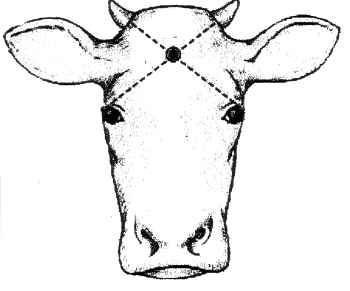 |
Correct position for shooting horned cattle with captive bolt. The exact location may vary slightly depending on the cattle breed and head shape. Splitting skulls with a band saw can be used to verify the ideal location for penetrating the brain. Diagram courtesy of Jan Shearer, Iowa State University, and AVMA 2013, 2020. Note: The "X" is drawn from the top of the eyes to the middle of the horns. This position raises the position of the shot. |
 |
Side view showing correct location for captive bolt placement for effective shots that penetrate the brain. The gun must be placed perpendicular on the skull surface for maximum hitting power. Angling the gun will reduce the ability of the captive bolt to penetrate the brain. Diagram courtesy of Jan Shearer, Iowa State University, 2011. |
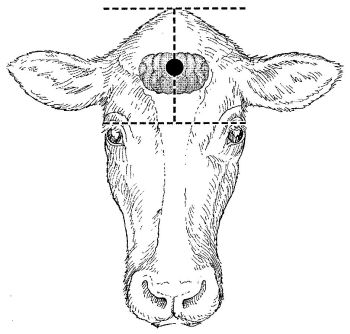 |
Position for shooting cattle with long heads, such as Holstein dairy cattle. AVMA 2020. Diagram courtesy of Jan Shearer, Iowa State University |
 |
Position for shooting goats. AVMA 2016. Diagram courtesy of Jan Shearer, Iowa State University |
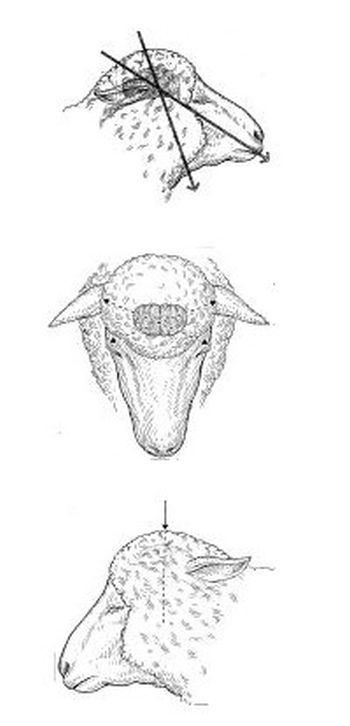 |
Position for shooting pulled sheep or goats. AVMA 2020. Collins et al, 2017; Plummer et al, 2018. |
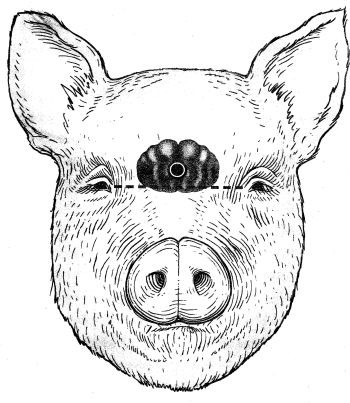 |
Position for shooting pigs. AVMA 2016, 2020. Diagram courtesy of Jan Shearer, Iowa State University |
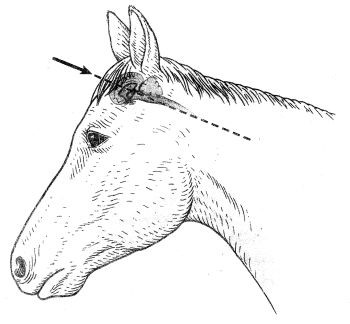 |
Position for shooting horses. AVMA 2020. Diagram courtesy of Jan Shearer, Iowa State University |
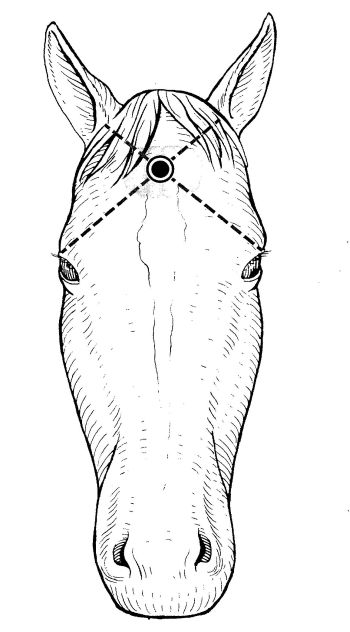 |
Position for shooting a horse. AVMA 2020. |
 |
 |
 |
 |
These photos show correctly applied captive bolt stunning. The animal is instantly rendered insensible to pain.
Plants that have an effective systematic approach to good captive bolt stunning practices will usually average about 96 to 98% of the animals rendered insensible with a single shot (Grandin, 2005). Some plants will routinely shoot animals twice to insure that they remain insensible. When the plant is being evaluated for stunning, the auditor or inspector should inspect the animal before the second shot is applied. The operator has to be able to demonstrate that he is capable of rendering 95% or more of the animals insensible with a single shot (Grandin, 2010). And experienced operator can easily achieve this (Atkinson et al., 2013). The reason the AMI guideline allows 5% extra shots is to enable the stunner operator to use an extra shot on a questionable animal. Operators who attempt to never take an extra shot are more likely to have problems with return to sensibility. Both the USDA/FSIS and the AMI have zero tolerance for stunning invasive procedures such as skinning or leg removal on an animal showing signs of return to sensibility (see section on determining insensibility).
Methods to Improve Captive Bolt Stunning
- Keep the captive bolt serviced and cleaned per the manufacturer’s instructions. Cartridge fired captive bolts MUST be completely taken apart and cleaned after each day of use. Even if the gun is shot only one, it must be taken apart and cleaned at the end of the shift. For pneumatic stunners, follow the manufacturer’s directions.
- Replace broken parts and do not attempt to straighten a bent cocking device. You should replace it.
- Keep cartridges dry; never store them in a damp location. Damp cartridges are a major cause of low powered, “soft” shots that are less effective. Soft sounding shots from cartridge fired captive bolts are less effective (Grandin, 2002; Gregory et al, 2007).
- On high speed lines, rotate cartridge fired captive bolts to prevent overheating. Overheated captive bolts lose hitting power.
- Use a test stand to determine if the captive bolt has sufficient bolt velocity. The bolt velocity should be 55 m/s for steers and cows and 70 m/s for bulls (Gregory, 2007; Gregory et al, 2007). For accurate results, the test stand must be mounted on a strong, solid surface.
- Pneumatic captive bolts must have a sufficient air supply to maintain the pressure specified by the manufacturer. The air supply should be equipped with a filter and lubricator and the compressor should have sufficient capacity to maintain the required pressure during peak production time.
- New cartridges directly from the manufacturer may vary in strength and performance (Grist et al, 2020). This may be due to variations in manufacturing.
- Calm animals are easier to render insensible (Gregory et al, 2007). Non-slip flooring is essential in stun boxes. Animals are more likely to leave agitated when they slip. Animals will be more willing to stand still on a non-slip surface. Steel rods can be welded into a grid to provide a non-slip floor.
- Locate and eliminate distractions that make animals refuse to enter the stun box or restrainer. Below is a list of simple things that can be done to reduce balking and refusing to enter the stun box:
- Add a light to illuminate a dark entrance.
- Eliminate air hissing.
- Block vision with solid panels so approaching animals do not look out onto the slaughter floor and see people and moving equipment.
- Adjust ventilation to prevent air drafts from blowing toward approaching animals.
- Provide plenty of back clearance on stun box entry doors. Animals may refuse to enter if the bottom of the gate is too low.
When captive bolt is used for halal slaughter, many Muslim religious authorities do not want stunning to kill the animal. After both types of captive bolt, the heart will continue to beat for several minutes (Vimini et al, 1983; Jerlstrom, 2004). If the animal is bled quickly, the heart will be beating at the time of bleeding. If bleeding is delayed, the heart will stop beating due to a lack of oxygen. Properly done, captive bolt stunning will instantly stop breathing. Farnuk (2013) explains that there are differences of opinion on the requirements for an animal to be alive at the time of slaughter. Many Muslim authorities will accept the animal as being alive if the heart is still beating. Some Jewish religious authorities require the animal to be both alive and conscious, but others will accept post cut captive bolt stunning.
There has been renewed interest in the use of non-penetrating captive bolt due to concerns about BSE (Bovine spongiform
encephalopathy). The elimination of stunners that injected air into the brain greatly reduced the amount of brain or spinal
cord tissue that could be spread to other parts of the body. However, research has shown that even when air injection had
been removed, small amounts of brain tissue may enter the body and brain tissue may contaminate plant equipment. The effective use of non-penetrating captive bolt requires much more accurate aim than a penetrating captive bolt. This will require the use of equipment to hold the animal's head. Designs for head holders can be found in the religious slaughter section of www.grandin.com and in the restraint for stunning section. Mushroom head non-penetrating captive bolt stunners inflict varying degrees of damage to the skull. Non-penetrating captive bolt that fractures the skull is more effective than a stunner that does not fracture the skull. Effectiveness increases as the degree of skull fracturing increases. It is likely that reducing the spread of at risk brain material is reduced when fracturing is minimized. Unfortunately, effective stunning and reducing skull fracturing are two opposite goals. As the amount of damage to the skull is reduced, placement of the shot must become more and more precise to achieve instantaneous insensibility. Shooting on a slight angle may result in failure to induce instantaneous insensibility. A mushroom head with a larger diameter may be more effective with less fracturing than a mushroom head with a small diameter.
Observations of the Jarvis pneumatic mushroom head non-penetrating stunner showed that it was effective on Zebu type cattle with very short hair. The plant had a head holding device to hold the bovine's head. The stunner fractured the skull but did not break the skin. Observations indicate that non-penetrating stunners may be less effective on cattle with woolly heads such as Herefords compared to short haired cattle.
2020 Update on non-penetrating captive bolt
Two new studies show that in adult cattle a non-penetrating captive bolt was less effective than a penetrating captive bolt. Gibson et al (2019) and Oliveira et al (2018) used a pneumatic stunner with either a penetrating bolt or mushroom head non-penetrating bolt on Zebu and Zebu Cross cattle. Results from Oliveira et (2018) are shown in the table. The use of non-penetrating captive bolt is not recommended for mature cattle or swine.
Comparison of Different Types of Captive Bolts
|
Non-Penetrating |
Penetrating |
| Second shot required |
29% |
12% |
| Immediate collapse |
91% |
99% |
| Righting behavior |
7% |
1% |
| Response to nostril stimulation |
2% |
0% |
| Eyeball rotation |
5% |
1% |
Gibson et al (2019) used a portable EEG to assess brain function. Zebu bulls shot with the pneumatic penetrating captive bolt had 100% with an EEG that indicated loss of consciousness. In the non-penetrating group only 82% showed waveforms indicating complete loss of consciousness.
2019 Update on non-penetrating on neonatal and young animals
A non-penetrating captive bolt with a mushroom head is effective for euthanizing neonatal animals. A series of papers by Grist et al (2017, 2018a,b,c) clearly showed that a non-penetrating captive bolt is effective for piglets up to 10.9 kg live weight, kid goats with an average live weight of 4.4 kg and lambs weighing 4.5 kg. The author observed piglets shot with the non-penetrating captive bolt and the skull was crushed. Young milk fed Holstein veal calves that were grown up to 227 kg (500 lbs) were also effectively rendered unconscious with a non-penetrating captive bolt (Bartz et al, 2015).
2019 Update on brain stem disruption and SRM dispersal
Studies conducted with cartridge fired captive bolt indicated that a shot in the correct position would penetrate the brain stem. Kline et al (2019) found that cattle shot with the Jarvis pneumatic captive bolt were rendered instantly unconscious even though the brain stem was still intact. The air pressure setting was 1370 to 1448 pka (200 to 210 psi). The stunner was effective with three bolt lengths of 15.2 cm, 16.5 cm, and 17.8 cm. All of the cattle were young fed English, Continental, European, and Holstein steers and heifers. During stunning the cattle were held in a center track (double rail) conveyor restrainer. This may have had an effect on the angle of the stun. Wagner et al (2019) reported that the longer bolt length did more visible damage to the brain. Bolt length had no significant impact on SRM (specified risk material) dispersion.
In plants using a non-penetrating captive bolt animal welfare should be evaluated with the North American Meat Institute scoring
system in the same manner as penetrating captive bolt. The plant must be able to stun 95% or more of the cattle correctly
with a single shot. They must be able to attain an acceptable score of 75% of the cattle moved with no electric prod and 3% or less of the cattle vocalizing. If a head restraint is used, a vocalization score of 5% is acceptable.
Heavy mature bulls are more difficult to stun with captive bolt compared to cows or fed beef. Practical experience in plants
indicates that heavy bulls are most effectively stunned with either a perfectly maintained cartridge fired penetrating
captive bolt stunner, a fire arm with a free bullet, or one of the new powerful pneumatic penetrating captive bolt stunners.
Stunning mature bulls correctly has been a continuous problem that has repeatedly shown up in restaurant audits. The stunning
of bulls with a non-penetrating stunner will need to be carefully monitored and audited to maintain a high standard of animal
welfare.
For large bulls and other heavy livestock such as bison, some plants routinely shoot them twice with a captive bolt. To verify that 95% or more are rendered insensible with one shot, the auditor or inspector should check for signs of return to sensibility BEFORE the second shot is done. A stunner shot that shoots in the air and does not touch the animal does not count. If the bolt of the stunner touches or partially penetrates the animal it is counted as a missed shot.
Some European regulations require that animals be bled within 45 to 60 seconds after captive bolt stunning. This is especially important after non-penetrating captive bolt. There have been questions on how to interpret this regulation that need to be clarified. If the first shot fails to render the animal completely insensible and the animal has to be shot a second time, how should the interval be timed? It should be timed AFTER the second shot. An animal showing signs of return to sensibility must NEVER be hung on the rail. This is a direct violation of USDA regulations and hanging a sensible animal would cause suffering.
The issue of stunner problems with brain tissue contamination must be kept in perspective. The carcass splitting saw also
spreads spinal cord tissue on the carcass (Bowling et al., 2007). Splitting saw contamination may possibly be worse than contamination from a
standard penetrating captive bolt.
Studies done under good commercial conditions show that contamination from brain proteins is low. A study done by Rovira et al (2007) at Colorado State University indicated that only one animal out of 360 had a positive GFAP immuno-assay for brain protein in the blood after penetrating captive bolt. Thirty cattle were sampled in 12 commercial plants. In 10 out of the 12 plants, the animals were shot with a single shot. The one positive sample occurred in a plant where the kill floor layout made it impossible to verify that the animal was shot with a single shot. A study done at the University of Bristol by Coore et al (2005) showed much higher levels of contamination. They used methods that may have confounded their results. The cattle were anesthetized and a catheter with a balloon was inserted into the jugular vein. There is a possibility that this device may have slowed down bleed out and changed blood flow patterns in the brain. Another study done under commercial conditions had results similar to the Colorado State study (Lucker et al, 2005).
2019 Update on kicking after captive bolt stunning
After animals are shot with a captive bolt they will often kick vigorously. This is due to reflexes. Cattle will continue to kick after the spine is severed (Terlouw et al 2015). This occurs because the circuits that provide the rhythmic movements for walking are located in the middle of the spinal cord (Griller, 2011; Griller and Jessell (2009)). In abattoir observations indicate that Holsteins kick more than the British/European beef breeds (Martin et al, 2018). Kicking should NEVER be used to determine if an animal is conscious (Bartz et al, 2015).
Safety Tips for Workers
- Cartridge-fired stunners must ALWAYS be un-cocked before they are set down.
- NEVER, NEVER throw a cartridge-fired stunner to another person.
- Inspect latches on stunning boxes to make sure they latch
securely. Before the next animal is admitted to the box, check the
latch.
- All guards must be kept in place over exposed pinch points which
could be easily touched by employees during normal operation of
the restrainer system equipment.
- If a worker has to get inside a restrainer conveyor system to
unjam it, lock it out first to prevent somebody else from turning it
on.
- Cartridge-fired stunners must always be kept unloaded when they
are carried away from the stunning area.
- Good maintenance is essential on pneumatic stunners to prevent
excessive recoil which can strain and injure the operators hands,
arms or back.
References
Atkinson, S., Velarde, A., and Algers, B. 2013. Assessment of stun quality at commercial slaughter in cattle shot with captive bolt. 22:473-481.
AVMA. 2013. AVMA Guidelines for the Euthanasia of Animals, 2013 Edition. American Veterinary Medical Association, Schaumberg, Illinois.
AVMA. 2016. AVMA Guidelines for the Humane Slaughter of Animals, 2016 Edition. American Veterinary Medical Association, Schaumberg, Illinois.
AVMA. 2020. AVMA Guidelines for the Euthanasia of Animals, 2020 Edition. American Veterinary Medical Association, Schaumberg, Illinois.
Bartz, B. et al, 2015. Assessment of non-penetrating captive bolt stunning followed by electrical induction of cardiac arrest in veal calves. Journal of Animal Science. 93:4557-4563.
Bowling, M.B., Yemm, R.S., Belk, K.E., Sofos, J.N., Smith, G.C., and Scanga, J.A. 2007. An evaluation of central nervous system cross-contamination due to carcass splitting in commercial beef packing plants. Journal of Food Protection. 71: 83-92.
Collins, S.L. et al, 2017. Comparison of penetrating and non-penetrating captive bolt methods in horned goats. American Journal of Veterinary Research. 78:151-157.
Coore, R.R., et al, 2005. Brain tissue fragments in jugular vein blood of cattle stunned by use of penetrating and non-penetrating captive bolt guns. Journal of Food Protection, 68:882-884.
Faruk, M.M. 2013. Advances in industrial production of halal and kosher meat. Meat Sciences, 95:805-820.
Lucker, E. et al, 2002. Studies of contamination of beef with tissues from the central nervous system (CNS) as pertaining to slaughter technology and human BSE exposure risk. Berl Munch Tierarztl Wochenscher, 115:118-121.
Gibson, T.J., Oliveira, S.E.O., Costa, F.A.D., and Gregory, N.G. 2019. Electro-encephalographic assessment of pneumatically powered penetrating and non-penetrating captive bolt stunning of bulls. Meat Science. 151:54-59.
Grandin, T. 1998. Objective scoring of animal handling and stunning practices in slaughter plants. Journal of Am. Vet. Med. Assoc. 212:36-39.
Grandin, T. 2002. Return to sensibility problems after penetrating captive bolt stunning of cattle in commercial beef slaughter plants. Journal Am. Vet. Med. Assoc. 221: 1258-1261.
Grandin, T. 2005. Maintenance of good animal welfare standards in beef slaughter plants by use of auditing programs. Journal Am. Vet. Med. Assoc. 226:370-373.
Grandin, T. 2019. NAMI Recommended Animal Handling Guidelines and Audit Guides. North American Meat Institute. Washington, D.C.
Gregory, N. et al. 2007. Depth of concussion in cattle shot with penetrating captive bolt. Meat Science. 77:499-503.
Gregory, N. 2007. Animal Welfare and Meat Production, 2nd Edition. Cabi Publishing. Oxfordshire, UK.
Grillner, S. 2011. Human locomotion circuits confirm. Science. 334:912-913.
Grillner, S and Jessell, T.M. 2008. Measured motion: Searching for simplicity in spinal locomotor networks. Current Opinion on Neurobiology. 19:572-586.
Grist, A., Murrell, J.C., McKinstry, J.L., Knowles, T.G., and Wotton, S.B. 2017. Humane euthanasia of neonates: Validation of the effectiveness of the Zephyr EXL non-penetrating captive bolt euthanasia system on neonate piglets up to 10.9 kg live-weight. Animal Welfare. 26:111-120.
Grist, A., Lines, J.A., Knowles, T.G., Mason, C.W., and Wotton, S.B. 2018. Use of non-penetrating captive bolt on neonate goats. Animals. doi:10.3390/ani8040058.
Grist, A., Lines, J.A., Knowles, T.G., Mason, C.W., and Wotton, S.B. 2018. The use of a non-penetrating captive bolt for the euthanasia of neonate piglets. Animals. doi:10.3390/ani8040048.
Grist, A., Lines, J.A., Knowles, T.G., Mason, C.W., and Wotton, S.B. 2018. The use of a mechanical non-penetrating captive bolt for euthanasia of neonate lambs. Animals. doi:10.3390/ani8040049.
Grist, A., Lines, J.A., Bock, R., Knowles, T.G., and Wotton, S.B. 2020. An examination of the performance of blank cartridges used in captive bolt devices for the pre-slaughter stunning and euthanasia of animals. Animals. 9(5):5523: doi.org/10.3390/ani9080552.
Jerlstrom, J. 2014. When and what determines the death of an animal? A study investigating the heart activity during slaughter of farm animals. Thesis. Swedish University, Skara.
Kline, H.C., Wagner, D.R., Edwards-Calloway, L.N., Alexander, L.R., and Grandin, T. 2019. Effect of captive bolt lengths on brain trauma and post hind leg activity in finished cattle Bos Tauras. Meat Science, 155:69-73.
Lambooy, E., and Spanjaard, W. 1981. Effect of shooting position on the stunning of calves by captive bolt. Vet. Record. 109:359-361.
Martin, M.S., Kline, H.C., Wagner, D.R., Alexander, L.R., Edwards-Calloway, L.N., and Grandin, T. 2018. Evaluation of different bolt lengths and breed influence upon post hind limb and forelimb activity in fed cattle in a commercial slaughter facility. Meat Science. 143:159-164.
Oliveira, S.E.O., Gregory, N.G., Dalla Costa, O.A., and Paranhos da Costa, M.J.R. 2018. Effectiveness of pneumatically powered penetrating and non-penetrating captive bolts in stunning cattle. Meat Science. 140:9-13.
Plummer, P.J. et al, 2014. Determination of anatomic landmarks for optimal placement in captive bolt euthanasia of goats. American Journal of Veterinary Research. 79:276-278.
Predergast, D.M., et al. 2003. Dissemination of central nervous system tissue from the brain and spinal cord of cattle after captive bolt stunning and carcass splitting. Meat Science. 65: 1201-1209.
Rovira, P.J., Scanga, J.A., Grandin, T., Hossner, K.L., Yemm, R.S., Belk, K.E., Tatum, D.J., Sofos, J.N., and Smith, G.C. 2007. Central nervous system tissue contamination of the circulatory system following humane cattle stunning procedures. Food Protection Trends. 27:524-529.
Teulouw, E.M., Bourquet, C., Deiss, V., and Mallet, C. 2015. Origins of movements following stunning and bleeding in cattle. Meat Science. 110:136-144.
Vimini, R.J. et al. 1983. Effect of delayed bleeding after captive bolt stunning on heart activity and blood removal in beef cattle. Journal of Animal Science. 57:628-631.
Wagner, D.R., Kline, H.C., Martin, M.S., Alexander, L.R., Grandin, T., and Edwards-Calloway, L.N. 2019. The effects of bolt length on penetration hole characteristics, brain damage, and specified risk material dispersal in finished cattle stunned with a penetrating captive bolt stunner. Meat Science, 155:109-114.
 Click here to return to the Homepage for more information on animal behavior, welfare, and care.
Click here to return to the Homepage for more information on animal behavior, welfare, and care.












